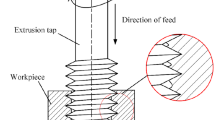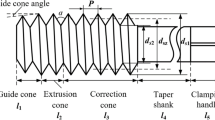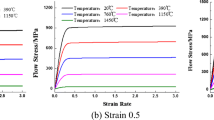Abstract
In this paper, the method of combining numerical simulation and experiment is used to study the flow law of metal during cold extrusion of internal threads and theoretically explain the strengthening mechanism of cold extrusion internal threads. By establishing a simplified mechanical model and a finite element model, the load change law of the tap during the extrusion process, the flow law of the metal and the surface hardening mechanism are studied. The research results show that during the extrusion process of the internal thread, the extrusion torque and the three-way load both increase first and then decrease and reach the maximum in the stable extrusion stage. When the internal thread is formed, the metal flows along the surface of the extruded prismatic teeth, and the metal flow rate in the crest area is the fastest and the displacement is the largest, followed by the metal flow rate and displacement in the flank area, and the metal flow rate in the tooth base area is the slowest and the displacement is the smallest. Compared with the original material, the hardness of the surface layer of the extruded internal thread is increased by 15% to 28%, and the hardness is proportional to the density of the metal fiber arrangement. The thread tensile test shows that when the tooth height ratio is between 65 and 80%, the tensile failure load of extruded internal threads is about 20% higher than that of cutting internal threads. Under the premise of the same tooth height, cold-extruded internal threads can withstand higher tensile loads than cutting internal threads. The above research results further clarify the plastic strengthening mechanism of the metal in the extrusion process of internal threads and have guiding significance for the performance evaluation of extruded threads.

















Similar content being viewed by others
Availability of data and material
Data sharing not applicable to this article as no datasets were generated or analyzed during the current study.
Code availability
No data, models, or code were generated or used during the study.
References
Ţălu S, Kulesza S, Bramowicz M, Sağlam H, Kus R (2020) Fractal geometry of internal thread surfaces manufactured by cutting tap and rolling tap. Manufact Lett 23:34–38. https://doi.org/10.1016/j.mfglet.2019.12.001
Hou HL, Chen X, Zhao YQ, He YY, Wang CQ (2021) The influence of the bottom hole of cold extruding internal thread on thread quality. Mechanika 27(4):335–341. https://doi.org/10.5755/j02.mech.27435
Brandão GL, Silva PMC, Freitas SA, Pereira RBD, Lauro CH, Brandão LC (2020) State of the art on internal thread manufacturing: a review. Int J Adv Manuf Technol 110(11–12):1–21. https://doi.org/10.1007/s00170-020-06107-x
Li YY, Zhao SD (2011) The key technology in extrusion tapping of internal thread. Adv Mater Res 295–297(295–297):2636–2641. https://doi.org/10.4028/www.scientific.net/AMR.295-297.2636
Liu M, Ji ZS, Fan R, Wang XG (2020) Finite element analysis of extrusion process for magnesium alloy internal threads with electromagnetic induction-assisted heating and thread performance research. Materials 13(9):2170. https://doi.org/10.3390/ma13092170
Zhang SW, Zhang DW, Wang YF, Zhu Q, Zhao SD, Luo W (2020) The planetary rolling process of forming the internal thread. Int J Adv Manuf Technol 107(5–8):3543–3551. https://doi.org/10.1007/s00170-020-05289-8
Hou YJ, Zuo DW, Sun YL, Liao ZN (2020) Semi-analytical torque modeling of Ti–6Al–4V-alloy internal trapezoidal thread extrusion forming with an emphasis on low-frequency torsional vibration. J Mater Process Technol 286:116812. https://doi.org/10.1016/j.jmatprotec.2020.116812
Hou YJ, Zuo DW, Wang L, Li L (2020) Experimental evaluation for internal trapezoidal thread with axial ultrasonic vibration cutting of Ti–6Al–4V. J Braz Soc Mech Sci Eng 42(5):247. https://doi.org/10.1007/s40430-020-02301-w
Miao H, Mei Q, Yuan JY, Jin YF, Zuo DW (2016) Low cycle fatigue and strengthening mechanism of cold extruded large diameter internal thread of Q460 steel. Chin J Mech Eng 29(3):556–563. https://doi.org/10.3901/CJME.2016.0318.033
Pereira IC, Silva MB (2017) Study of the internal thread process with cut and form taps according to secondary characteristics of the process. Int J Adv Manuf Technol 93:2357–2368. https://doi.org/10.1007/s00170-017-0573-x
Barooah RK, Paiva JM, Arif AFM, Rawal B, Bose B, Veldhuis SC (2021) Investigation on wear mechanisms of PVD coatings for form taps in threading of Al-Si alloy. Wear 464–465:203528. https://doi.org/10.1016/j.wear.2020.203528
Filho SLMR, Panzera TH, Brandão LC, Abrão AM (2021) Influence of cutting speed and tool geometry on form and machine tapping of carbon fibre-reinforced composites. J Braz Soc Mech Sci Eng 43(2):107. https://doi.org/10.1007/s40430-021-02839-3
Júnior RCE, Pereira RBD, Lauro CH, Brandão LC (2020) Research on the wear mechanisms during the high-speed tapping in 316L stainless steel. Int J Adv Manuf Technol 112:419–436. https://doi.org/10.1007/s00170-020-06368-6
Swissi A, Soussi H, Abid M, Krichen A (2019) Internal and interface shear behaviors of cut and form tapping thread. Int J Adv Manuf Technol 105(7–8):3463–3475. https://doi.org/10.1007/s00170-019-04519-y
Oliveira JA, Filho SLMR, Brandão LC (2019) Investigation of the influence of coating and the tapered entry in the internal forming tapping process. Int J Adv Manuf Technol 101:1051–1063. https://doi.org/10.1007/s00170-018-3011-9
Hou YJ, Zuo DW, Sun YL, Li L (2019) Distributional analysis of residual stresses with the Ti–6Al–4V internal trapezoidal thread torsional vibration extrusion. Int J Adv Manuf Technol 105:4289–4307. https://doi.org/10.1007/s00170-019-04472-w
Funding
This project was funded by the Shaanxi Provincial Natural Science Basic Research Project (Yongqiang Zhao, 2019JM-466), the Shaanxi Provincial Department of Education Special Scientific Research Project (Yongqiang Zhao, 18JK0148), and the Shaanxi University of Technology Graduate Innovation Fund Project (Xin Chen, SLGYCX2027).
Author information
Authors and Affiliations
Contributions
Xin Chen is mainly responsible for the planning of research content and the writing of papers. Hongling Hou is mainly responsible for the revision of research content and the revision of the paper. Wu Lang is mainly responsible for the establishment of finite element model and numerical simulation analysis. Tao Huang and Miaoyuan Mei are mainly responsible for the preparation before the test and the follow-up of the test process. Yongqiang Zhao is mainly responsible for data sorting and analysis.
Corresponding author
Ethics declarations
Conflicts of interest
The authors declare there is no conflicts of interest regarding the publication of this paper.
Ethics approval
Not applicable.
Consent to participate
The consent of all authors has been obtained.
Consent for publication
The consent of all authors has been obtained.
Additional information
Technical Editor: Lincoln Cardoso Brandao.
Publisher's Note
Springer Nature remains neutral with regard to jurisdictional claims in published maps and institutional affiliations.
Rights and permissions
About this article
Cite this article
Chen, X., Hou, H., Wu, L. et al. Research on metal flow law and strengthening mechanism of cold extrusion internal thread. J Braz. Soc. Mech. Sci. Eng. 44, 109 (2022). https://doi.org/10.1007/s40430-022-03418-w
Received:
Accepted:
Published:
DOI: https://doi.org/10.1007/s40430-022-03418-w




